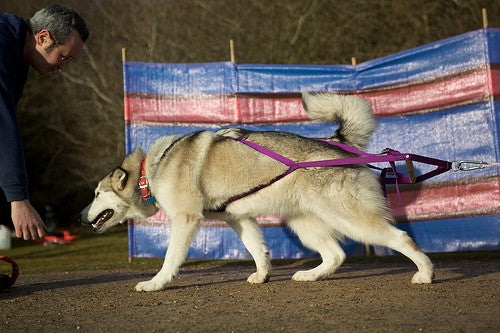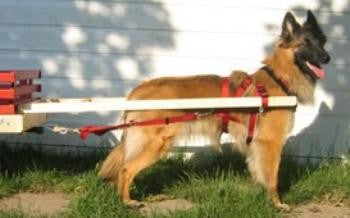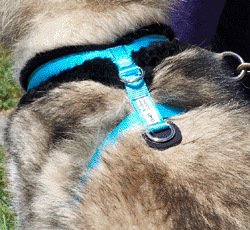Great article here written by our friends across the pond at Howling Dog Alaska
In this article, we bring you useful information that will help everyone, especially the ones starting out in the sport of mushing – whether your goal is to race or recreate on snow or dryland. First, we need to define conditioning versus training. Training teaches behavior such as taking turns, slowing down, speeding up, or stopping. Here we will be addressing basic early-season conditioning for dogs to reach their optimum fitness level through exercise and nutrition. Proper exercise (conditioning) and nutrition go hand in hand. Either one on its own is not enough. You must address both areas. Keep in mind that the frame of reference in this article is feeding and conditioning a team of sprint racing sled dogs that run three to four times a week.

GETTING IN SHAPE
The best way to start getting your dogs in shape is by playing, walking, and loose running them in the summer. They will learn how to use their bodies and feel comfortable with speed. Being agile comes in handy later when dodging obstacles on the trail. Loose running and zooming around will make them comfortable with a top speed. Another important thing is strengthening your dog’s ligaments and tendons, and increasing their aerobic capacity in the offseason before hooking them up to work in a harness. Professional mushers do this by having their dogs trot long, slow miles on an exercise wheel. People with one or two dogs can do the same by simply going on hikes with your dogs. You will have the benefit of getting in shape, too.

CONDITIONING
Keep the first fall run in harness with the four-wheeler (or a cart) short. The distance for the first few runs will vary anywhere from one to three miles depending on the capability of your dogs, on the breed of your dogs, and on your goals later on in the season. However, do not go further than three miles. Run at a relatively slow speed with some rest stops included. Subsequent runs lessen the amount of rest and add a little more speed. In about ten runs, you will build up to completing the run with no rest and dogs looking like they still had some “gas in the tank”. After that bump up in miles and the speed with the same progression, let’s say up to five miles for ten training runs, and so on. Only you can be the judge of the capability of your team.
IMPORTANT: Overtraining can lead to a downward spiral in performance, rest is as important as the run itself (exercise tears down muscles and rest builds them up even better). Variety is the spice of life. Once your dogs get in decent shape, you will want to vary their conditioning routine to keep their little minds excited about new things. Take new trails, have an extra day off, run two days in a row, do free runs in-between working in harness – anything to keep the dogs happy and engaged in their favorite activity.

DIET
Now let’s look at nutrition. The base diet fed to your canine athletes should be a high-quality kibble that is 30% protein and 20% fat. High-quality kibble will always be well balanced with a vitamin/mineral pack that is especially important and hard to duplicate on one’s own. Make sure you soak the kibble in water before feeding to keep the dogs hydrated. Going further into the fall conditioning season, your dogs will be burning increasing amounts of calories. If you are not already doing so, you will need to start mixing meat with the kibble then. How do you know when to start doing this? The indicator will be either, 1) Your dogs will start losing weight, or 2) Your dogs will start having runny stool after the run. Some of you might be able to get a commercially prepared mix of beef or chicken, liver, egg, oils, and bone meal put together especially for the use in working dogs. If you can’t get your hands on such a mix, simply add ground beef. We do not recommend feeding a raw diet, however, if you believe in feeding raw, there are some commercial vitamin/mineral additives available for purchase to supplement the raw diet. Also adding bone meal is necessary when feeding a raw diet. As you get into the race season, the percentage of meat in your diet will increase. However, feeding more than 50% of meat in the diet is not necessary (50% kibble, 50% meat).

HYDRATION
Each dog should consume about two liters of water a day including what’s added to their meal and including their free access water. You can monitor this by assessing the color of the dog’s urine. The goal is to be as clear as gin. It is important to go into a training run with a well-hydrated team. “Water” your dogs with about 0.75 liters of baited water about two hours before the run. If desired you can also give your dogs an additional two cups of lightly baited water about 30 minutes prior to the run. Make sure your dogs have free access to water after the run or give them baited water (at least two cups).
SUPPLEMENTATION
Adding psyllium husk to the diet will be beneficial for GI tract health (it will firm up the stool). Adding Nutrazinc will promote tough feet, and adding Astaxanthin, a super antioxidant, will prevent the buildup of lactic acid in muscles. Keep in mind that during early warm-weather training (or during races held in warmer weather), replenishing electrolytes after the run is a must (use Mineral Drink). If you can, use maltodextrin (After Drink or Mamut Recovery Drink) after the heats of multi-day races to aid muscle glycogen replacement. For increased stamina, use Pre Run Drink, an L-Carnitine supplement. Supplementing is highly effective when combined with a good feeding and conditioning regimen and will give you an edge against your competition. Without the whole package, though, it is like trying to “pixie dust” your dogs into performing well and you won’t realize the true benefits of the additives.
CONCLUSION
Remember that all dogs are individuals, and you can’t “make” your dog into something it’s incapable of. You can, however, help your dog reach his/her full potential through proper nutrition, training, and conditioning.
Don’t hesitate to contact us should you have any questions regarding this topic. We will be happy to give you professional advice.
Check out our all of our supplements:








































































